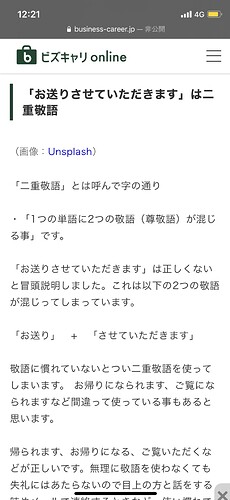I’m sure this grammar point is already on Bunpro?
Nothing showed up on search and it isn’t in the list of related grammar points on てあげる
Gorganite’s response was to another user, it seems!
A question to the bunpro staff, when do you guys plan to add these missing points and the missing audio? How much is left for a 100% complete grammar completion? Like for example if I do every single grammar point available right now would I be able to understand any anime and manga?
You’d be able to understand the grammar they use for sure. But you also need vocabulary knowledge to complement that. Given both, you’d be well on your way to reading whatever you want.
They’ve been gradually adding both over time.
Assuming you practice vocab at the same time, and ideally kanji, you should start to understand things very quickly.* I found manga to be workable around N4 level, and it just gets easier from there.
*Very quickly as in, as you study, you’ll be able to quickly identify the things you’ve studied. Reading fast comes with practice of reading, not just grammar/vocab studies alone.
~てみせる is one I’ve seen around but isn’t on Bunpro
かと思う - I suspect that…/I imagine that…/I get the feeling that…
It was used in an N3 level listening test
I am currently studying Tobira ch. 4 and I’ve noticed a missing grammar point:
I was also wondering if the なんか grammar point could be put in between the とかんがえられている and まず grammar points to mirror the order in which they appear in Tobira.
Apologies if this has already been mentioned; anyway, I don’t think ~まし is covered on the site yet, right?
^This is the only page a quick Google search brought up for me for this grammar point, so it looks like it might not be common/well-known?
Might also be worth having a grammar point for ~ませ.
This grammar point is the one for まし. The building blocks are slightly different but it essentially has the same meaning.
This is one of my favourite grammar points because I remember saying that I’d rather eat my 母の料理 to mushrooms (I hate mushrooms) - My Japanese teacher said 文法大丈夫だけどマシューさんのお母さんの料理はまずいですか。 and I said とってもまずいです! - the whole class exploded in laughter… so that’s why I will never forget that grammar point.
Any plans to add させていただく?
Also, on the example sentences for お(v)いたします I was getting rejected for adding in お送りさせていただきます for example, but had thought they mean essentially the same thing and are pretty interchangeable?
Your poor mom!
In these cases, I recommend using the “report” button on the review page! You can explain to the devs what alternate answer(s) might be possible and could/should be accounted for by the program 
Has anyone mentioned のみ yet? だけ is accounted for, but not のみ.
I believe that there is no grammar point for 「しかし」
If I understand it well it’s a more common and shorter version of 「しかしながら」(https://bunpro.jp/grammar_points/674) but this one is in the JLPT1 course while 「しかし」 is listed as JLPT5 on https://jlptsensei.com/learn-japanese-grammar/しかし-shikashi-meaning/
JLPT1 is a long run away from the JLPT5, so maybe it would be a good idea to add it as another point in JLPT5.
References I could find on this grammar point:
- https://jlptsensei.com/learn-japanese-grammar/しかし-shikashi-meaning/
- 【だが】と【しかし】と【でも】の意味の違いと使い方の例文 | 例文買取センター
- https://hinative.com/ja/questions/6606758
- BUT in Japanese - でも vs けど vs が vs のに vs しかし┃the Native Way - YouTube [Japanese Ammo with Misa]
Edit: Now that I think about it, there is no grammar point for でも either, as in, used at the beginning of the sentence to mean “but”. Is it because it’s considered as a vocabulary point instead of a grammar one ?
I haven’t tried the answer input that you suggested, but are you sure that it wasn’t rejected because you wrote 送りさせていただく、instead of 送らせていただく?
Ooft, I can’t remember. Seemingly お送りさせていただく is often used but not actually correct keigo. I might have written that.
A lot of Japanese people make mistakes with keigo even, so I wouldn’t sweat it. I looked it up last night in Japanese and couldn’t find a 100% definitive answer anywhere. For me, something just sounds off about お送りさせていただく. I’ll ask my partner later today, she may know.
お送りさせていただくって言うのは、間違いだってはるなが言った。理由は、2つの敬語があるから。これを読んで表れます。
It’s double keigo, and although lots of people use it, apparently it is considered wrong. Almost similar to how lots of English native speakers say things like
‘I don’t like ___ neither’ etc.
Wrong, but so often said that some consider it right.


